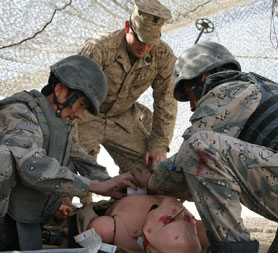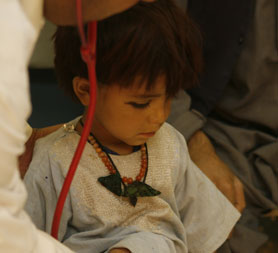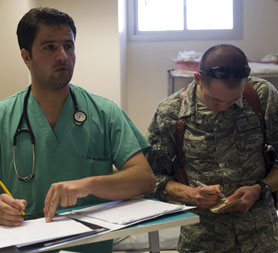Civilians treated in military hospitals in Afghanistan
How does the military treat civilian casualties in Afghanistan? Channel 4 News hears from Colonel Christopher Castle, ISAF Joint Command Medical Advisor.

Military hospitals are set up primarily to care for military casualties, and the hospitals in Afghanistan are no exception.
But the demand from Afghan civilians is so high, as a result of the combination of the intensity of the fighting and the country’s dilapidated healthcare system, that on occasion there are more civilians being treated in military facilities than soldiers.
Colonel Christopher Castle, medical advisor for the International Security Assistance Force (ISAF) in Afghanistan, told Channel 4 News: “Usually, up to 20 per cent of our admissions are civilian casualties, but just today for example 53 per cent of our beds that are occupied, are occupied by civilians.
“And I don’t think that’s unusual given the nature of the health system in Afghanistan.”
Around 90 per cent of the casualties treated in military hospitals – both civilian and military – are war wounded, although the hospitals do also take other trauma cases, to save life, limb or eyesight. On a case by case basis, other patients with acute medical needs are admitted as well.

But the military takes priority.
“If there’s an operation, for example around Hamkari, bed space around Kandahar is at a premium,” said Colonel Castle.
“We’ll do what we can to evacuate patients to other facilities. But the system is rarely running at capacity – and no one in urgent need of care is refused.
“I’m not sure I’m ready to say that on any day 50 per cent of our beds are occupied by locals, but it wouldn’t surprise me.”
These high numbers remain the case despite Colonel Castle’s stated preference for the Afghan system to deal with its own patients.
“Our first choice is…to treat them in Afghan facilities. That’s partly because of capacity and partly because we’re trying to help them develop their capabilities…But we don’t release them until they’re stable enough to be transferred,” he said.
“We don’t take everyone that walks up to the gate…the system’s not designed to treat the whole of Afghanistan. Afghanistan has more health needs than almost anywhere in the world…You hear stories in the press about a child bitten by an adder who is sure to die and the father will show up at the nearest forward operating base and ask for help – and where we can give it we give it.”
Transfers to civilian hospitals
But when they cannot give care, military hospitals transfer patients to civilian and hospitals run by non-governmental organisations (NGOs) – around 110 a month.
The Afghan Government is attempting to build up these hospitals, but with very low investment.

Colonel Castle said that sending civilians back to facilities which cannot be as well-equipped as military facilities was “a concern”, but patients had to move through the system to allow more people to be treated.
“It’s a concern…it does create some challenges when you are releasing patients to a system which isn’t as able to take care of them over the long term,” he said, adding that the coalition had a “soft spot” for children and would sometimes treat them rather than transfer them to facilities where the paediatric units were not adequately equipped.
But he said long-term rehabilitation of civilians – including things like prosthetic limbs – was a “local responsibility” and the military did not track patients it transferred.
“We save their lives and that’s a good thing,” he said. “We are in the business, in terms of taking care of local nationals, we’re saving life and limb. Rehabilitation is really a local responsibility.”
He said healthcare in Afghanistan had to be seen in the context of a system decimated after thirty years of war.
“What we’re trying to do is apply the resources we have in the most effective way to get the best overall health outcome for the population,” he said.
“That definitely doesn’t mean that an Afghan civilian released from our hospital is being released to a Western standard of care – that’s just not possible and won’t be for a decade. But we’re making progress…the numbers are bleak but they are getting better.”
-
Latest news
-
Laughing Boy: New play tells the tragic tale of Connor Sparrowhawk5m

-
Sewage warning system allows some of worst test results to be left off rating system, analysis shows3m

-
Post Office inquiry: Former CEO didn’t like word “bugs” to refer to faulty IT system4m

-
Israeli soldier speaks out on war in Gaza12m

-
PM’s defence spending boost should be ‘celebrated’, says former Armed Forces Minister4m

-




